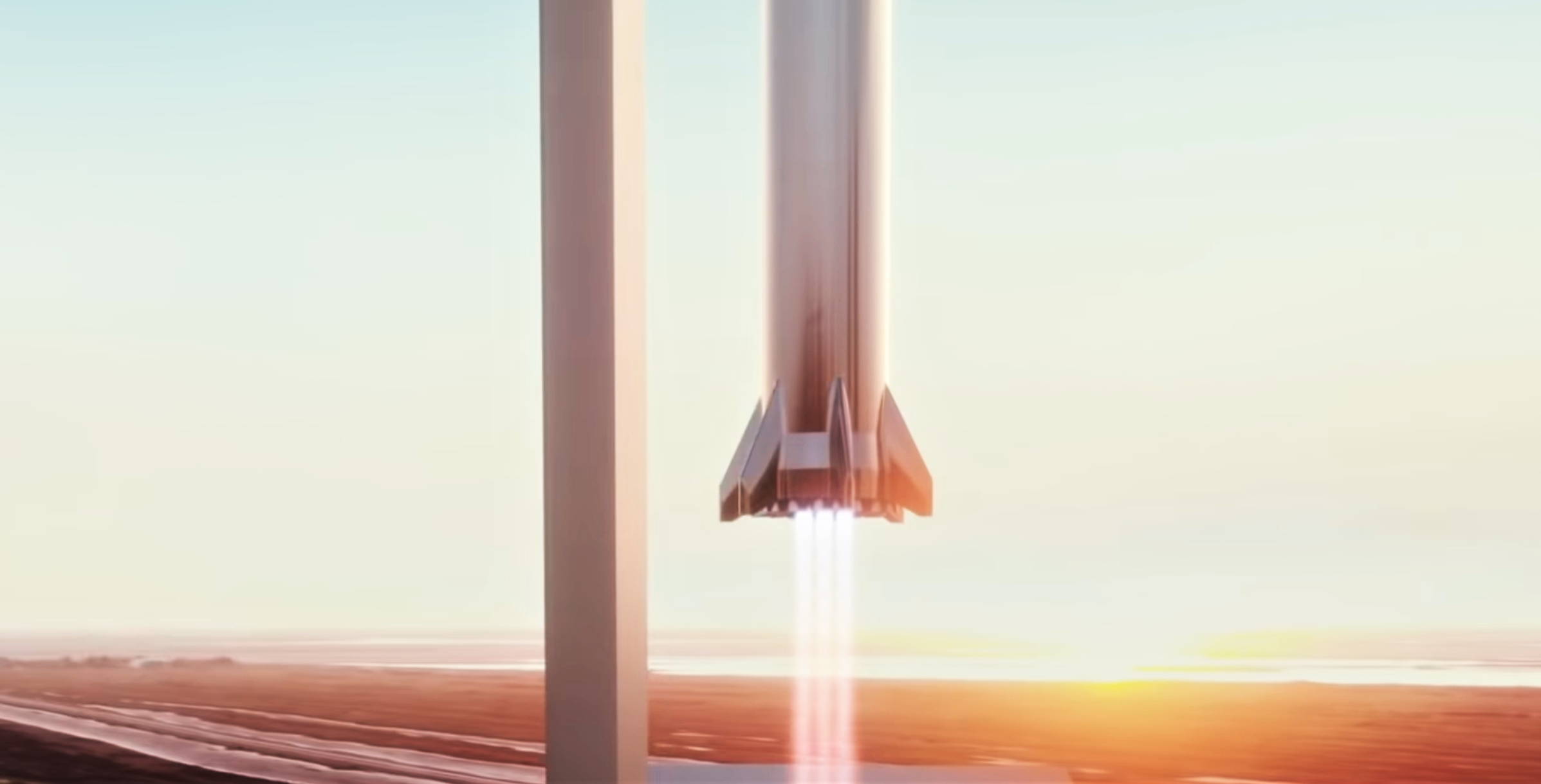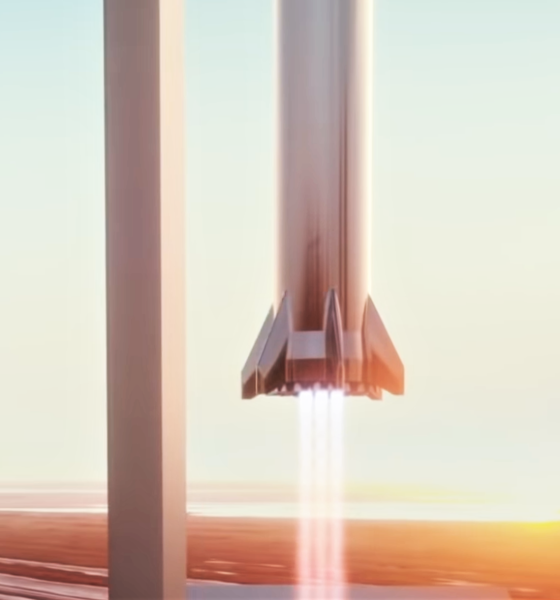

News
SpaceX’s second Super Heavy booster might land in Mechazilla’s arms
CEO Elon Musk says that SpaceX could attempt to catch a Super Heavy booster out of mid-air with a tower-sized ‘Mechazilla’ robot as early as Starship’s second orbital launch attempt.
Speaking on Twitter just hours after SpaceX installed said Starship launch tower’s first arms, Musk has thankfully answered a question on the minds of many: how many prototype boosters must be expended? In a move that can be only described as unexpected, SpaceX revealed plans to fully expend its first orbital-class Starship and Super Heavy booster pair in May 2021 FCC filings, confirming (or strongly implying) that no true recovery attempts would be made.
Instead, in what could be described as a quasi-orbital debut, SpaceX intends to launch the first two-stage Starship to an altitude of around 200-300 km (TBD). Like many Falcon boosters, Super Heavy will separate a few minutes after liftoff, flip around, and boost back towards the South Texas coast, where it will attempt a soft landing 20 miles offshore in the Gulf of Mexico. Reading between the lines of Musk’s latest info, depending on the results of that ocean landing attempt, SpaceX might attempt to catch the second flightworthy Super Heavy booster on the very next launch.
Heading towards a similar fate, Starship will continue onwards and upwards like a Falcon upper stage. Based on its FCC application, SpaceX seems to have implied that Starship will stop just short of true orbit – traveling slow enough to passively reenter Earth’s atmosphere before completing a full trip around the planet. Of course, it’s possible that SpaceX simply left out plans for an intentional deorbit burn, but it does make sense that the company might try to lock in safeguards for such an ambitious inaugural test flight.
In other words, if Starship were to fail during the ~80 minutes it would spend coasting in space, its launch trajectory design would more or less passively prevent a Russian roulette scenario reminiscent of China’s recent spate of uncontrolled reentries. The feats facing Super Heavy are thankfully a fair bit simpler, though Starship booster recovery does pose its own hurdles.
In an apparent effort to reduce risk, SpaceX intends to fully expend the first flightworthy Super Heavy (potentially Booster 4) and all 29 of its Raptor engines. There will be no attempt at all to land the booster or its one-of-a-kind engines at land or on a sea-based platform – partly because Elon Musk appears to have endeavored to entirely prevent the installation – and, perhaps, the design and assembly – of legs. Instead, in one of the eccentric executive’s less intuitive gambles as of late, SpaceX will entirely dispense of more than half a decade of experience landing 90+ Falcon boosters on legs to attempt to catch Super Heavy boosters out of the air with house-sized arms tacked onto a 145m (~475 ft) tall tower.

No different than a hypothetical landing with legs, Super Heavy will still have to boost back to land, coast, and fire up several Raptor engines for a final landing burn – only on tiny handle-like hardpoints and giant moving arms instead of legs and a concrete pad. If catching boosters eventually proves reliable enough to be a worthwhile reinvention of the wheel, the only apparent benefit of the approach will be a slight reduction in Super Heavy’s dry mass.
According to Musk, though, SpaceX might not have to wait long to find out just how viable a recovery method ‘Mechazilla’ really is and will “hopefully” attempt to catch Super Heavy Booster 5 (B5) after Starship’s second orbital launch attempt. Presumably, that attempt is contingent upon FAA approval and on Booster 4 successfully simulating a smooth, accurate landing in the Gulf, as even a minor issue during a catch attempt could catastrophically damage pad hardware that would take months to repair or replace.
For now, it’s almost impossible to say when Starship S20 and Super Heavy B4 will be ready for their orbital launch debut, as that now lies almost solely in the hands of the FAA. In theory, the FAA could complete environmental reviews and grant SpaceX a launch license as few as two or so months from now. In practice, SpaceX could be forced to sit and wait for at least 6-12 more months. Regardless, SpaceX has already begun assembling and staging sections of Ship 21 and Booster 5, so the company could be ready for an extremely rapid turnaround (and Mechazilla’s first catch attempt) after Starship’s orbital launch debut – whenever that may come.

News
Tesla FSD fleet is nearing 7 billion total miles, including 2.5 billion city miles
As can be seen on Tesla’s official FSD webpage, vehicles equipped with the system have now navigated over 6.99 billion miles.

Tesla’s Full Self-Driving (Supervised) fleet is closing in on almost 7 billion total miles driven, as per data posted by the company on its official FSD webpage.
These figures hint at the massive scale of data fueling Tesla’s rapid FSD improvements, which have been quite notable as of late.
FSD mileage milestones
As can be seen on Tesla’s official FSD webpage, vehicles equipped with the system have now navigated over 6.99 billion miles. Tesla owner and avid FSD tester Whole Mars Catalog also shared a screenshot indicating that from the nearly 7 billion miles traveled by the FSD fleet, more than 2.5 billion miles were driven inside cities.
City miles are particularly valuable for complex urban scenarios like unprotected turns, pedestrian interactions, and traffic lights. This is also the difference-maker for FSD, as only complex solutions, such as Waymo’s self-driving taxis, operate similarly on inner-city streets. And even then, incidents such as the San Francisco blackouts have proven challenging for sensor-rich vehicles like Waymos.
Tesla’s data edge
Tesla has a number of advantages in the autonomous vehicle sector, one of which is the size of its fleet and the number of vehicles training FSD on real-world roads. Tesla’s nearly 7 billion FSD miles then allow the company to roll out updates that make its vehicles behave like they are being driven by experienced drivers, even if they are operating on their own.
So notable are Tesla’s improvements to FSD that NVIDIA Director of Robotics Jim Fan, after experiencing FSD v14, noted that the system is the first AI that passes what he described as a “Physical Turing Test.”
“Despite knowing exactly how robot learning works, I still find it magical watching the steering wheel turn by itself. First it feels surreal, next it becomes routine. Then, like the smartphone, taking it away actively hurts. This is how humanity gets rewired and glued to god-like technologies,” Fan wrote in a post on X.
News
Tesla starts showing how FSD will change lives in Europe
Local officials tested the system on narrow country roads and were impressed by FSD’s smooth, human-like driving, with some calling the service a game-changer for everyday life in areas that are far from urban centers.

Tesla has launched Europe’s first public shuttle service using Full Self-Driving (Supervised) in the rural Eifelkreis Bitburg-Prüm region of Germany, demonstrating how the technology can restore independence and mobility for people who struggle with limited transport options.
Local officials tested the system on narrow country roads and were impressed by FSD’s smooth, human-like driving, with some calling the service a game-changer for everyday life in areas that are far from urban centers.
Officials see real impact on rural residents
Arzfeld Mayor Johannes Kuhl and District Administrator Andreas Kruppert personally tested the Tesla shuttle service. This allowed them to see just how well FSD navigated winding lanes and rural roads confidently. Kruppert said, “Autonomous driving sounds like science fiction to many, but we simply see here that it works totally well in rural regions too.” Kuhl, for his part, also noted that FSD “feels like a very experienced driver.”
The pilot complements the area’s “Citizen Bus” program, which provides on-demand rides for elderly residents who can no longer drive themselves. Tesla Europe shared a video of a demonstration of the service, highlighting how FSD gives people their freedom back, even in places where public transport is not as prevalent.
What the Ministry for Economic Affairs and Transport says
Rhineland-Palatinate’s Minister Daniela Schmitt supported the project, praising the collaboration that made this “first of its kind in Europe” possible. As per the ministry, the rural rollout for the service shows FSD’s potential beyond major cities, and it delivers tangible benefits like grocery runs, doctor visits, and social connections for isolated residents.
“Reliable and flexible mobility is especially vital in rural areas. With the launch of a shuttle service using self-driving vehicles (FSD supervised) by Tesla in the Eifelkreis Bitburg-Prüm, an innovative pilot project is now getting underway that complements local community bus services. It is the first project of its kind in Europe.
“The result is a real gain for rural mobility: greater accessibility, more flexibility and tangible benefits for everyday life. A strong signal for innovation, cooperation and future-oriented mobility beyond urban centers,” the ministry wrote in a LinkedIn post.
News
Tesla China quietly posts Robotaxi-related job listing
Tesla China is currently seeking a Low Voltage Electrical Engineer to work on circuit board design for the company’s autonomous vehicles.

Tesla has posted a new job listing in Shanghai explicitly tied to its Robotaxi program, fueling speculation that the company is preparing to launch its dedicated autonomous ride-hailing service in China.
As noted in the listing, Tesla China is currently seeking a Low Voltage Electrical Engineer to work on circuit board design for the company’s autonomous vehicles.
Robotaxi-specific role
The listing, which was shared on social media platform X by industry watcher @tslaming, suggested that Tesla China is looking to fill the role urgently. The job listing itself specifically mentions that the person hired for the role will be working on the Low Voltage Hardware team, which would design the circuit boards that would serve as the nervous system of the Robotaxi.
Key tasks for the role, as indicated in the job listing, include collaboration with PCB layout, firmware, mechanical, program management, and validation teams, among other responsibilities. The role is based in Shanghai.
China Robotaxi launch
China represents a massive potential market for robotaxis, with its dense urban centers and supportive policies in select cities. Tesla has limited permission to roll out FSD in the country, though despite this, its vehicles have been hailed as among the best in the market when it comes to autonomous features. So far, at least, it appears that China supports Tesla’s FSD and Robotaxi rollout.
This was hinted at in November, when Tesla brought the Cybercab to the 8th China International Import Expo (CIIE) in Shanghai, marking the first time that the autonomous two-seater was brought to the Asia-Pacific region. The vehicle, despite not having a release date in China, received a significant amount of interest among the event’s attendees.








